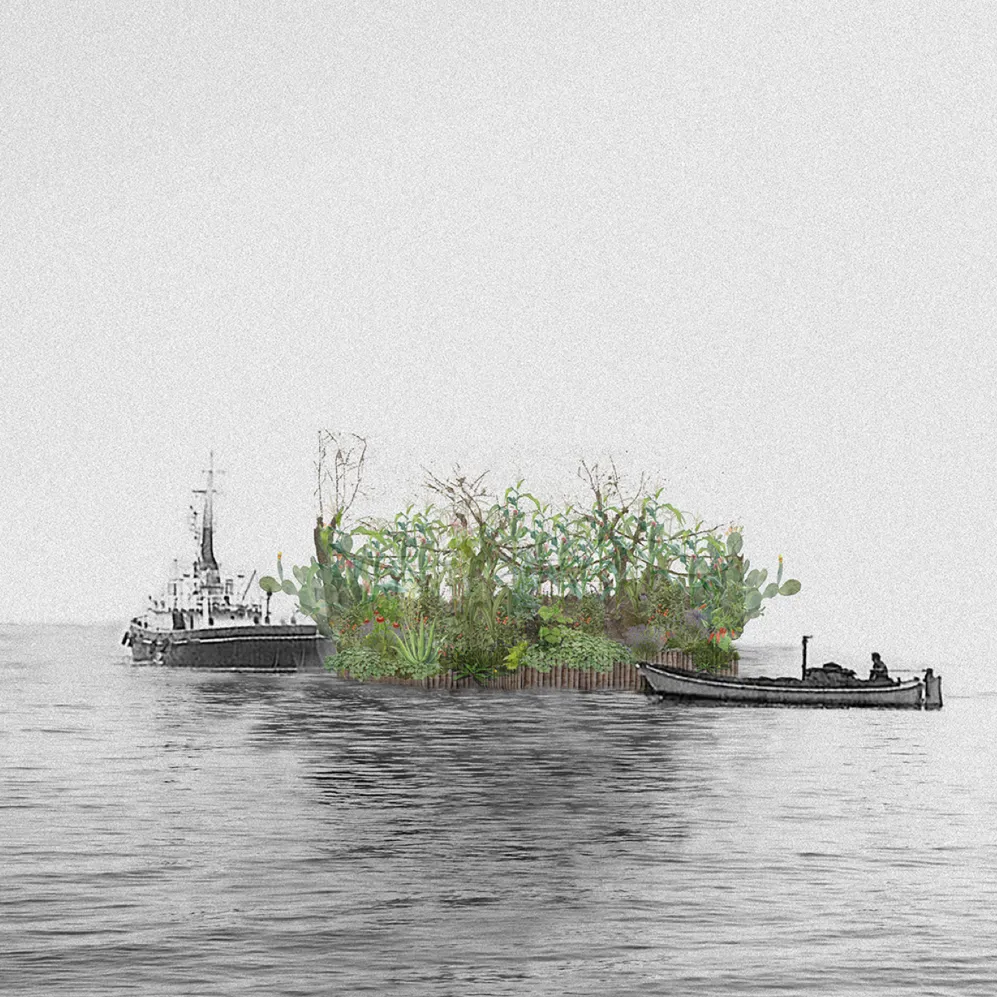
Words Vidula KotianDate 06 May 2025
Responding to this call, Mexico’s pavilion Chinampa Veneta bridges two water-based cultures, reimagining the ancient Mesoamerican chinampa using organic materials from Italy’s Veneto region. A living installation in the heart of Venice, it merges tradition with regeneration, memory with future thinking. We caught up with members of the collective ahead of the pavilion’s opening—architect Sana Frini, graphic designer María Marín de Buen, architect and curator Jachen Schleich, agroecologist Lucio Usobiaga, and architects Ana Paula Ruiz Galindo and Mecky Reuss—to talk about agroforestry, collective authorship, and what it means to plant a seed, literally and metaphorically, in the Biennale.

Jachen Schleich: It was strongly connected to the biennale’s theme: Intelligens: Natural. Artificial. Collective. Chinampas embody this concept—they're ancient, man-made farming systems. The Valley of Tenochtitlan (Mexico City) was once composed of five lakes, vast wetlands. In the southern part, where freshwater springs emerged, Mesoamerican people began building islands on the lake using organic material. These chinampas were stabilized by trees with rooted borders, creating fertile, biodiverse platforms to grow food, vegetables, and more.
This method is especially relevant today, as we face global challenges—rising sea levels, food security, public health. The chinampa holds millennia of knowledge on how to live with water, not against it, and how to cultivate in ways that regenerate rather than deplete.
Sana Frini: When we started, we shared a common will to explore something with deep value—not just for its regenerative potential, beauty, or ecosystem benefits, but for its efficiency, its positive impact, and its longevity. It’s a system from the past, yet deeply relevant today, especially in the context of the Anthropocene and the destruction caused by humans—plastic, pollution, collapse.
What drew us in was that it’s a non-fossil system. It doesn’t rely on fuels. It functions scientifically, almost mechanically — as a living system, a machine. And yet, it’s in danger. Part of that danger comes from repeating the same patterns elsewhere. That’s where the connection with Venice began to take shape.
María Marín de Buen: We started digging deeper and discovered that Mexico and Venice were both declared UNESCO World Heritage Sites in 1987—and now both are at risk of losing that status due to ecological crisis. The parallels became clear. We brought in the iconic Teatro del Mondo, Aldo Rossi’s floating theater, which was also part of the first Biennale—speaking to the idea of culture in motion, not static, connecting places and people.
We realized this paradise we’re working with reflects challenges shared by Venice, Mexico, and places all over the world—water, climate change, food systems. What’s happening to farmers? Why did we create such a divide between city and landscape? Those questions became central to the proposal.
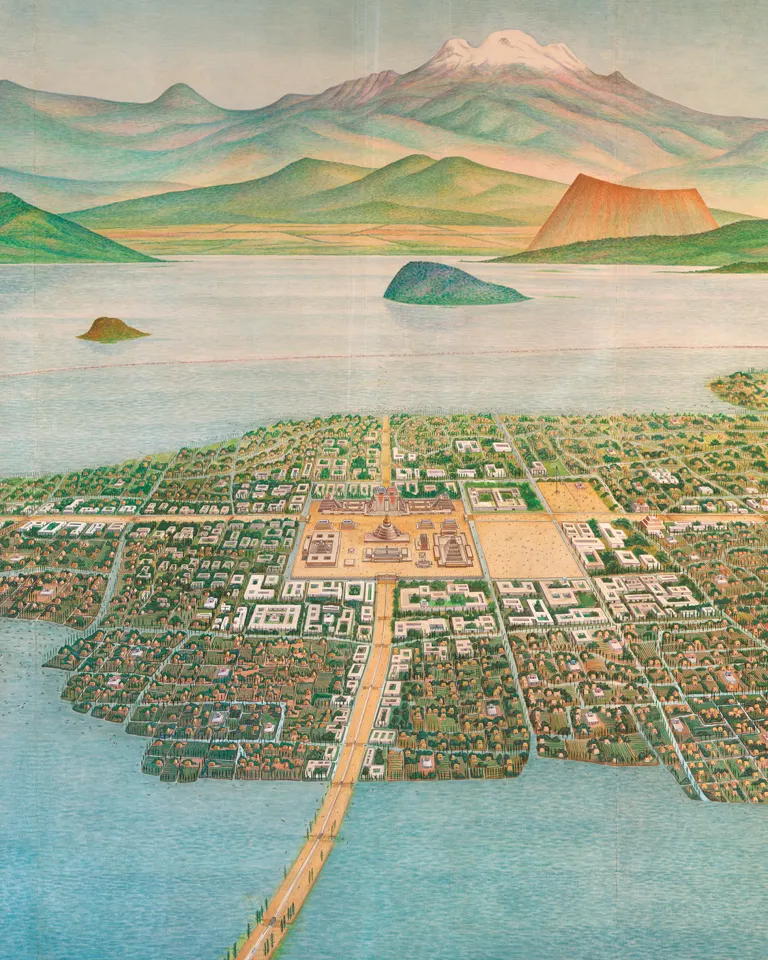
A historical depiction of Xochimilco, where waterways and chinampas shaped daily life and urban form
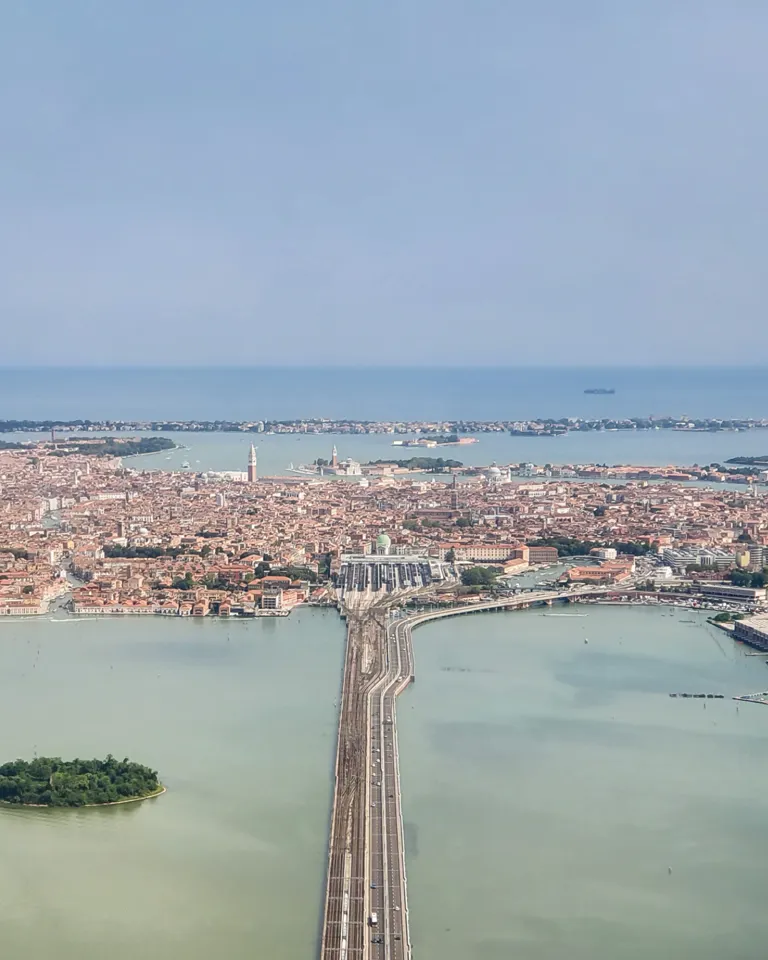
A modern aerial view of Venice —an iconic city built on water, facing the ongoing challenges of preservation
María Marín de Buen, founder of Estudio María Marín de Buen
Lucio Usobiaga: In agriculture—my field—there’s been a lot of debate about what truly counts as sustainable. Organic farming hasn’t been enough; it often just swaps inputs while keeping the same model of producing commodities. It may skip chemicals, but it still exploits soil and labor. In Latin America and Africa, we talk about agroecology because it integrates both ecological and social dimensions. We work with agroecological practices, and within that, agroforestry is one of the most powerful regenerative tools. It mimics natural ecosystems. Chinampas, originally, are agroforestry systems—they’re bordered by trees. So is the Vite Maritata, where trees support the vines. Trees recycle nutrients through pruning and sequester carbon.
Milpas don’t always include trees, but they’re polycultures—corn, beans, squash—each crop supporting the others. Corn provides structure, beans fix nitrogen, and squash covers the ground to retain moisture and suppress weeds. In just months, they generate huge amounts of organic matter, enriching the soil or feeding animals. That’s the core of regenerative agriculture: building organic matter, enhancing soil life, and supporting ecosystems. But these systems also carry deep cultural value. They’re ancient technologies that show how peasant communities have long sustained not just food, but knowledge, resilience, and culture
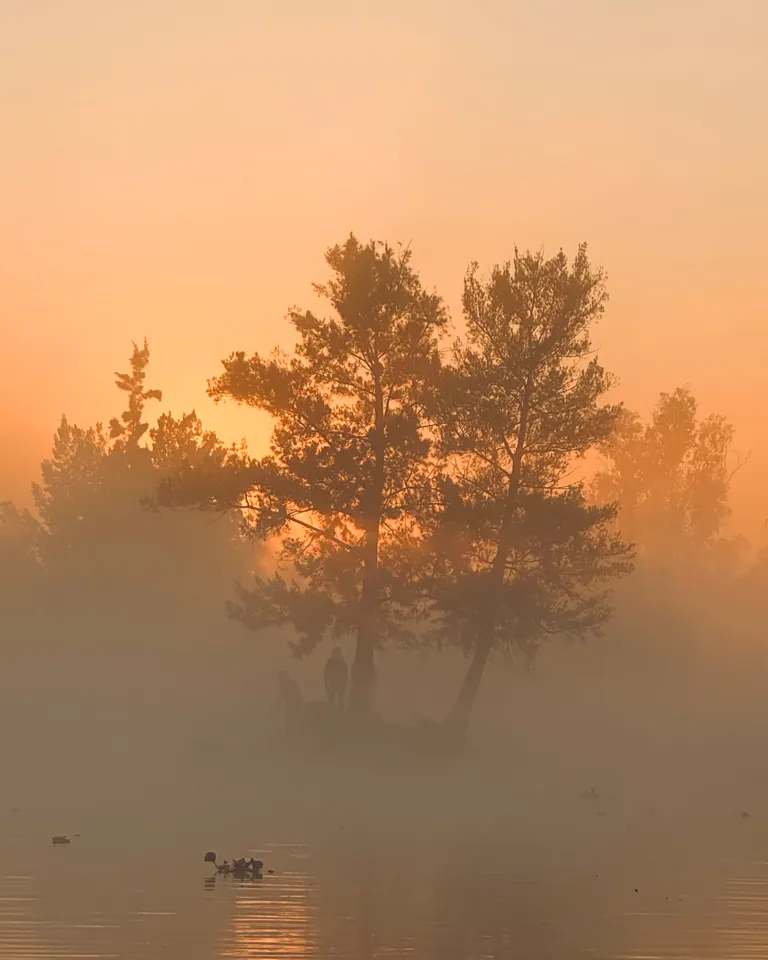
At dawn in Xochimilco, farmers are keepers of ancient waterscapes
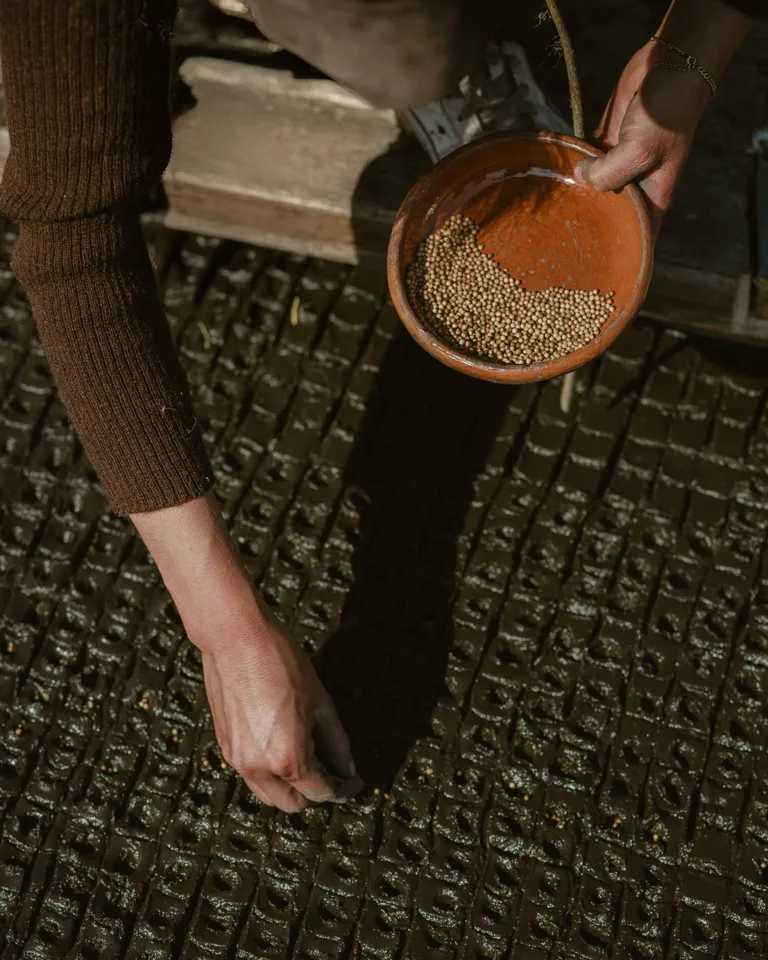
Seeding the chinampa: a gesture of care, tradition, and regeneration
Sana: Six months ago, we had no idea we’d be working as a collective. But through this process, we discovered how to collaborate—across disciplines, perspectives, and even nationalities. Some of us are Mexican, some not. We come from different ecosystems, ways of thinking, and professional backgrounds. What brought us together was mutual respect and the understanding that everyone had something meaningful to contribute. That in itself felt political—because collaboration is fragile, and yet essential, especially in a world struggling to work collectively.
What also shaped the project was our shared desire to shift the conversation from sustainability to regeneration. In architecture, that hasn’t always been possible. It’s a field responsible for a huge portion of global pollution, and yet rarely questions its own systems. Being able to represent regenerative circular systems at the Venice Biennale—systems that are non-extractive, non-fossil, non-harmful—is a statement. It shows that other ways of building and producing are possible, ways that are thoughtful, functional, and alive.
Our pavilion is designed to continue beyond Venice. It questions design driven by mechanical systems and instead proposes nature-based solutions. And we’re very conscious of our role—we’re not trying to speak over the chinamperos or claim expertise. We’re here to amplify their knowledge, to reflect their generosity, and to shine a light on their resistance. What’s happening in Xochimilco matters. I hope visitors leave reflecting on how we live, what we build, and how we might redefine our relationship with nature—and with each other.
María: Our pavilion proposes two acts. One is the chinampa at the center—the protagonist of the space. The other is the womb chinampa, which invites the visitor to take part in its regeneration.
Lucio: The central chinampa represents a synthesis of ancestral and contemporary practices—a meeting point between ancient knowledge and science. Then there’s the womb chinampa, which invites visitors to place a seed on a cube of mud, cover it with compost, and water it. These cubes are later transplanted into dry, cracked soil—like the degraded land we see across the world.
More than a metaphor for regeneration, it invites a shift in how we see ourselves. Carlo Petrini, founder of the Slow Food movement, said we shouldn’t be called consumers, but co-producers—supporting farmers, eating seasonally. We can take that further. Wherever you live, you can plant. The message of the womb chinampa is simple: we’re all part of the solution.

Sana Frini, co-founder of Locus
Ana Paula Ruiz Galindo: Working as a collective is hard. People struggle with it because they don’t know who to give credit to. There’s still this idea that one person should be the genius behind everything—a deeply individualistic mindset. With tight deadlines, it was even harder to navigate group dynamics. But I think it’s essential. It represents a necessary shift for a generation raised to center the individual. It’s not easy to unlearn, but it’s absolutely necessary.
Jachen: Regenerative design demands a different methodology—one where all stakeholders are involved, not just the creative lead. That’s essential if we want truly regenerative solutions. For our generation, it’s still hard to break away from the top-down model. It’s not about having the best idea—it’s about making space for many. This shift is inevitable, and we’re all navigating it in our own work. It’s a challenge, but it’s necessary.
Mecky: We started with a base frame for the pavilion, and tried to extra-territorialize it—push it beyond the Giardini and outside the usual Biennale framework, which has its own limitations. That’s the beauty of the competition: it lets you test ideas. Even if the project only lasts six months, it can be transformative.
We didn’t fully manage to break the frame—we still have a pavilion, and it’s quite monumental, with blocks of earth shaped by human intervention. These proto-agricultural systems carry deep knowledge. Even as professionals, working with them felt raw and unfamiliar. But that’s where the learning is.
The Chinampa Veneta Collective comprises of Estudio Ignacio Urquiza and Ana Paula de Alba, Estudio María Marín de Buen, ILWT, Locus (Sana Frini and Jachen Schleich), Lucio Usobiaga Hegewisch & Nathalia Muguet, and Pedro&Juana.